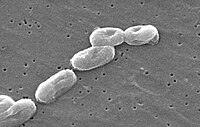
Photo from wikipedia
Burkholderia cenocepacia is an opportunistic bacterial pathogen that poses a significant threat to individuals with cystic fibrosis by provoking a strong inflammatory response within the lung. It possesses a type… Click to show full abstract
Burkholderia cenocepacia is an opportunistic bacterial pathogen that poses a significant threat to individuals with cystic fibrosis by provoking a strong inflammatory response within the lung. It possesses a type VI secretion system (T6SS), a secretory apparatus that can perforate the cellular membrane of other bacterial species and/or eukaryotic targets, to deliver an arsenal of effector proteins. The B. cenocepacia T6SS (T6SS‐1) has been shown to be implicated in virulence in rats and contributes toward actin rearrangements and inflammasome activation in B. cenocepacia‐infected macrophages. Here, we present bioinformatics evidence to suggest that T6SS‐1 is the archetype T6SS in the Burkholderia genus. We show that B. cenocepacia T6SS‐1 is active under normal laboratory growth conditions and displays antibacterial activity against other Gram‐negative bacterial species. Moreover, B. cenocepacia T6SS‐1 is not required for virulence in three eukaryotic infection models. Bioinformatics analysis identified several candidate T6SS‐dependent effectors that may play a role in the antibacterial activity of B. cenocepacia T6SS‐1. We conclude that B. cenocepacia T6SS‐1 plays an important role in bacterial competition for this organism, and probably in all Burkholderia species that possess this system, thereby broadening the range of species that utilize the T6SS for this purpose.
Journal Title: MicrobiologyOpen
Year Published: 2019
Link to full text (if available)
Share on Social Media: Sign Up to like & get
recommendations!